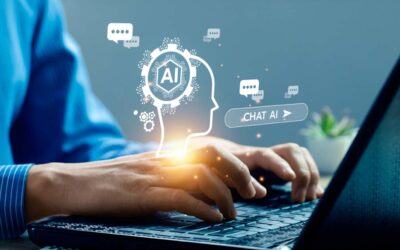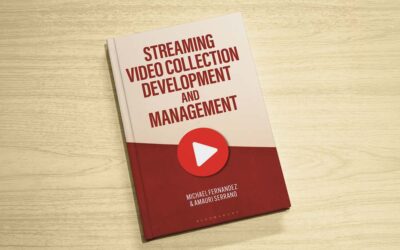Artificial Intelligence: Technology Trends that Aren’t “Out-There” Anymore!

Stephen Abram
In a recent post, I listed nine newer technologies not just on the horizon but quickly having an impact on both the consumer space and coming fast into our spaces—libraries, archives, museums, and galleries (the so-called GLAM sector).
For the next nine posts I’ll highlight some of the trends in each and explore the impact they may have on our profession and sector(s).
Don’t bury the lede! My personal insight is that we’re reaching a new era of convergence. We’re progressing past the convergence of devices (think how your smartphone encompasses device convergence—music player, camera, books, video players and recorders, web browsing, payments, and, oh yeah, a telephone and more!) into a world where these 9 technology interventions combine data, software, and experience to create a fundamentally new world of information experiences based on behaviour.
Consider the weight of the 1965 iPhone:
Let’s explore each trend in turn and think about what’s on the horizon coming at our field, culminating in Web 4.0.
Artificial Intelligence
ar·ti·fi·cial in·tel·li·gence
noun
the theory and development of computer systems able to perform tasks that normally require human intelligence, such as visual perception, speech recognition, decision-making, and translation between languages.” (OED)
Artificial Intelligence, combines expert systems, Natural Language Processing, pattern recognition and robotics. This combination is reaching towards simulating many human capabilities such as reading, writing, grasping, calculating, speaking, remembering, comparing numbers, drawing, making judgments, and even interactive learning. Researchers are working on the systems that have the ability to reason, to learn or accumulate knowledge to strive for self-improvement, and to simulate human sensory and mechanical capabilities. Experts are convinced that it is now only a matter of time; the present generation will experience the impact and utility of new applications based on artificial intelligence in offices, factories, libraries and homes. This general area of research is known as ‘Artificial Intelligence’.
Artificial Intelligence mainly focuses on understanding and performing intelligent tasks such as reasoning, learning new skills and adapting to new situations and problems. Artificial Intelligence, or AI for short, is a combination of computer science, psychology, and philosophy. It is concerned with the concept and methods of symbolic inferences by computer and the symbolic representation of knowledge to be used.
“Artificial Intelligence focuses on symbolic, non-algorithmic problem-solving methods. Intelligence relies on the ability to manipulate symbols. The goal of its sub areas i.e. expert system, Natural Language Processing, pattern recognition, and robotics is to simulate human intelligence with computers.” (Footnote i)
Note that non-algorithmic methods include access to big and small data on behaviours—searching, browsing, profile, etc. Libraries can access and exploit these data.
Librarians are experts! “In artificial intelligence, an expert system is a computer system that emulates the decision-making ability of a human expert. Expert systems are designed to solve complex problems by reasoning through bodies of knowledge, represented mainly as if–then rules rather than through conventional procedural code.“
Natural Language Processing is one of the long-standing goals of computer science—to teach computers to understand the language we speak. “Natural Language Processing (NLP) is a branch of artificial intelligence that helps computers understand, interpret and manipulate human language. NLP draws from many disciplines, including computer science and computational linguistics, in its pursuit to fill the gap between human communication and computer understanding.”
“Pattern Recognition is the process of establishing a close match between some new stimulus and previously stored stimulus patterns. This process is being performed continually through the lives of all living things. Pattern recognition is studied in many fields, including psychology, ethnology, cognitive science and computer science. Pattern recognition is based on either a priori knowledge or on statistical information extracted from the patterns. The patterns to be classified are usually groups of measurements or observations, defining points in an appropriate multi dimensional space.” (Wiki, 2014) The components of pattern recognition are; data acquisition, pre-processing, feature extraction, model selection and training, and evaluation.”
Artificial Intelligence and its applications in Libraries
“Computers provide the perfect medium for the experimentation and application of Artificial Intelligence technology in the present era. AI has more success at intellectual tasks such as computer-based game playing and theorem proving than perceptual tasks. Sometimes these computer programs are intended to simulate human behaviour and they are built for technological applications also such as Computer Aided Instruction (CAI). In many cases the main goal is to find any technique that does the task quick in the better way.” (footnote i)
Library work is usually related to the reading materials, database development and access, collection development and research and reference for users and staff. The application of Expert Systems will help the librarian in realizing the need for an improvement in the productivity. A well programmed Expert System will also improve quality.
Applications of Expert Systems in Reference Service:
“Reference service is a prime activity of any library and the Expert System will work as a substitute for a reference librarian. Following are some of the examples of Expert Systems used for Reference Service.
(a) REFSEARCH: It is a system that supplies patrons, the recommended sources to lookup certain questions. The system can be used to teach students reference skills or as a computerized aid for practicing reference librarians and information specialists.
(b) POINTER: It was the early successful working application of computer system in the area of reference work. It directs the users to the reference sources; It is not a Knowledge Based System but a computer assisted reference program.
(c) Online Reference Assistance (ORA): This system was intended to stimulate the services of an academic reference Librarian for questions of low and medium level, by using several technologies: a videotext like database, computer assisted instruction modules, and a knowledge-based system. ORA consists of Directional transactions like library locations, services and polices.
(d) ANSWERMAN: A knowledge-based system to help users for reference questions on agriculture topics. It uses series of menus to narrow down the subject of the questions and the type of tool needed. It can function as either a consultation system or as a front end to external databases and CD-ROM reference tools.
(e) PLEXUS: This is a referral tool used in Public Libraries. It includes knowledge about the reference process, information retrieval about certain subject areas, reference sources, and library users. All the above systems are advisory systems for locating reference source books and factual data. (footnote i)
(f) META: Check out Meta a medical research start-up which is now part of the Chan-Zuckerberg Initiative. It is a predictive search engine that tells where the research is heading.
Application of Expert Systems in Cataloguing:
Cataloguing is one of the oldest library crafts. Recent attempts to automate cataloguing through Expert Systems have focused on descriptive cataloguing because it is considered rule-based (AACR2). Recent developments in lined data as well as Bibframe provide enormous opportunities in the creation—automatically and on demand—of services and content quickly and at high quality.
“a) A human-machine interface, where the intellectual effort is divided between the intermediary and the support system; and…
b) An Expert System with full cataloguing capability linked into an electronic publishing system, so that as a text is generated on-line, it can be passed through knowledge-based systems and cataloguing process is done without any intellectual input from an intermediary.“ (footnote i)
Application of Expert Systems in Classification:
“Classification is the fundamental activity in the organization of knowledge. For this reason, it is prominent in all systems for organizing knowledge in libraries and information centers. Application of Expert System in the area of classifications in libraries includes the following:
- (a) Coal SORT: It is a conceptual browser designed to serve either as a search or an indexing tool. Coal SORT consists primarily of a frame-based semantic network and the software needed to allow users to display portions of it and to move around in the conceptual structure. The expert knowledge in the system is embodied almost entirely in the semantic network. There is no procedural knowledge in the system.
- (b) EP-X: The Environmental Pollution Expert (EP-X) has certain things in common with coal SORT in that both are concentrating on enhancing interface using a Knowledge Based approach. The knowledge base of EP-X consists of a hierarchical frame-based semantic network of concepts and a set of templates that express the patterns called the pragmatic relationship among concepts. These patterns are referred to as conceptual information.
- (c) BIOSIS: A knowledgebase, that includes a significant amount of procedural knowledge, to assign documents to categories automatically. It is designed as an indexer aid. BIOSIS uses the information in the titles of biological documents to assign as many categories as possible of those that would be assigned by human indexers. The indexing languages are structured and practical representation of information that can be used to very good advantage of AI applications.“ (footnote i)
Application of Expert Systems in Indexing:
“Indexing of periodicals and other content is another area where expert systems are being developed. Indexing a periodical article involves identification of concepts, to translate these concepts into verbal descriptions, and selecting and assigning controlled vocabulary terms that are conceptually equivalent to verbal descriptions. The reason for automating the intellectual aspects of indexing is to improve the indexing consistency and quality. Based on the information provided by the indexer, the systems can arrive at appropriate preferred terms automatically to assign relevant subdivisions. The system can make inferences and based on the inference, it can take appropriate action.’ Med Index’ is the best example of an indexing system used in the library indexing activity.“ (footnote i)
Application of Expert Systems in Acquisition:
The collection of documents is another integral part of the library. The librarian or the information officer is the key person in this activity. The users of the library have a significant role to play in building electronic collections andtheir help and advice should be solicited in the process. Several systems have been incorporated. Monograph Selection Advisor, a pioneering effort in applying this emerging technology in another area of Library Science i.e. building library collection. Specifically, the task modeled is the item-by-item decision that a subject bibliographer makes in selecting monographic. The knowledge base has to be broad enough and the interfacing aspect must be easy enough for the library to get the desired information from the machine.
Applications of Natural Language Processing (NLP) in Library Activities:
“When we think of the term NLP, the first thought is being able to speak or write in a complete sentence and have a machine process the request and speak. NLP can be applied to many disciplines.To apply this to the field of Library and Information science and more specifically to searching databases such as online public access catalogs (OPAC).“(footnote i)
NLP is becoming more and more available – especially when we play with the emerging voice response systems represented by Alexa, Siri, and Cortana.
Application of Pattern Recognition in Library Activities:
“In this era of the Internet and distributed, multimedia computing, new and emerging classes of information systems applications have swept into the lives of office workers and everyday people. New applications ranging from digital libraries, multimedia systems, geographic information systems, and collaborative computing to electronic commerce have created tremendous opportunities for information researchers and practitioners. “
Exploring the emergent field of a semantic analysis in the form of semantic networks, decisions, rules, or predicate logic. Spreading activation-based inferencing methods are often used to traverse various large-scale knowledge structures (aaai.org/AITOPICS,2014).
“One of the major trends in almost all emerging information systems applications is the focus on the user-friendly, graphical, and seamless Human-Computer Interactions. The Web-based browsers for texts, images, and videos have raised user expectations on the rendering and manipulation of information. Recent advances in the development of languages and platforms such as Java, OpenGL, and VRML and the availability of advanced graphical workstations at affordable prices have also made information visualization a promising area for research.”
Indeed, it is here we will see the convergence of text, video, GPS, graphics, data and more as we break down the siloes of the past where format of content drove database content standards.
Advantages of Artificial Intelligence
- a) Can take on stressful and complex work that humans may struggle /cannot do;
- b) Can complete tasks faster than a human can most likely;
- c) To discover unexplored things. i.e. outer space;
- d) Fewer errors and defects;
- e) Function is infinite.
Disadvantages of Artificial Intelligence
- a) Lacks the “human touch”
- b) Has the ability to replace human jobs
- c) Can malfunction and do the opposite of what they are programmed to do
- d) Can be misused leading to mass scale destruction
- e) May corrupt younger generation (footnote i)
Conclusion
For sure there will be bumps in the road. From intellectual freedom, copyright, access, walled gardens, patents, to information literacy and more, libraries provide guides that have helped guide intellectual growth for centuries. In the age of AI, those principles are more relevant than ever. “As machine learning proliferates, what steps can we take to ensure that the values of librarianship are incorporated into AI systems? Advocacy should be directed not at maintaining traditional librarianship, but in influencing the development of the emerging information systems that may come to replace us.”
The practicability of artificial intelligence in the areas such as cataloguing, classification, documentation, collection development etc. appears to be improving very fast and billions of dollars in equity capital are pursuing this mother lode. The introduction of AI techniques into Library and Information Science will be another juggernaut our field will need to contend with.
Suggested readings:
- Footnote i: (PDF) Artificial Intelligence and its applications in Libraries. [accessed Oct 31 2018].
- Artificial Intelligence & Libraries: Prepare Yourself » Dysart & Jones…
- Artificial intelligence and the library of the future, revisited » Stanford…
- An AI Lab in a Library » American Libraries Magazine
- Artificial intelligence arrives in the library » Information and Learning…
- IBM Artificial Intelligence » Watson APIs and Solutions
- Gartner AI Research Guide » Don’t get left behind
-Stephen

Stephen Abram
Similar Posts
Growing Your Leadership Skills: 7 Tips for Special Librarians
Great library leaders aren’t born—they’re made through learning self-reflection and practice. Here are seven strategies to help you grow and lead with impact.
Keeping Up with Copyright and Generative AI: What Special Librarians Need to Know
As generative AI becomes more prevalent copyright law is evolving to address its impact. A new report from the U.S. Copyright Office provides guidance on what is (and isn’t) copyrightable.
Understanding Shadow AI: Risks Costs and Governance
AI can enhance search discovery and efficiency but unsanctioned adoption—known as “shadow AI”—can lead to budget overruns and compliance risks. Here’s how to evaluate AI pricing models and build a governance strategy that balances innovation with cost control.
Interview with an Author: Fernandez on Streaming Video Collection Development
As demand for streaming video in libraries grows so do the challenges of managing access budgets and licensing. Co-author Michael Fernandez shares key insights from his book “Streaming Video Collection Development and Management”.








Leave a Comment
Comments are reviewed and must adhere to our comments policy.
0 Comments